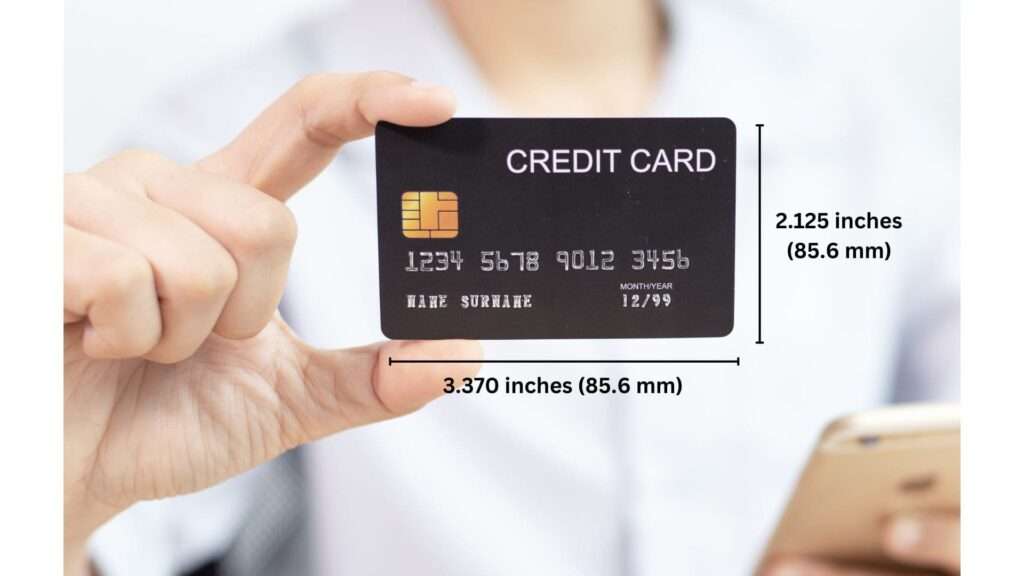
Ever wondered why your credit card fits perfectly in every machine? Credit card size follows a global standard. This ensures that cards issued by any bank or credit union work seamlessly worldwide. According to the ISO standard, credit cards have precise dimensions. The thickness remains consistent, whether for plastic or metal credit cards.
These specifications ensure compatibility with ATMs and card readers globally. This article provides a complete guide on the standard dimensions of credit cards. Learn why all cards are the same size and how these standards emerged.
Credit Card Size
Standard Measurements:

- Credit cards have dimensions of 85.6 mm by 53.98 mm.
- These measurements also translate to 3.370 inches by 2.125 inches.
- Both credit cards and debit cards adhere to these standard measurements.
- Identification cards often follow the same size for uniformity.
Global Standard:
- The International Organization for Standardization (ISO) sets the global standard.
- According to ISO/IEC 7810, the standard size is 85.60 mm by 53.98 mm.
- This standard size ensures compatibility with card readers and ATMs globally.
- Bank cards, including those from Bank of America, comply with these standards.
- Both plastic and metal cards follow these international dimensions.
Thickness of a Credit Card
Typical Thickness:
Credit cards typically have a thickness of 0.76 mm, which equals 0.03 inches. This standard thickness allows for compatibility with card readers and ATMs. Most credit and debit cards follow this specification to ensure seamless use. The International Organization for Standardization (ISO) sets these dimensions to maintain uniformity across different types of cards.
Variations in Thickness:
Some cards, like metal cards, can be thicker than the standard 0.76 mm. These variations in thickness cater to specific market demands and user preferences. Metal cards often provide a premium feel and additional durability. However, despite being thicker, they must still fit in standard card readers and ATMs.
Standard Credit Card Features
- The standard dimensions of a credit card ensure its universal compatibility with card machines.
- Typical credit card thickness is 0.76 mm, allowing it to fit into any card reader.
- The front of the card contains the card number, cardholder’s name, and expiration date.
- The back of the card includes the card verification value (CVV) for security purposes.
- Cards are made from durable plastic or metal for enhanced durability and longevity.
- Every credit card must adhere to ISO standard specifications.
- Metal credit cards offer a premium feel and added weight compared to plastic cards.
- Rewards cards provide incentives such as cashback, points, or miles for purchases.
- Platinum cards often come with higher credit limits and exclusive benefits.
Credit Card Issuers
Credit card issuers include banks and credit unions, providing various card options tailored to consumer needs. Major issuers like Visa, Mastercard, and American Express dominate the market, offering a range of card features and benefits. Since the first credit card was issued, the industry has evolved, introducing metal credit cards and enhanced security measures. Banks and credit unions issue cards that adhere to global standards for size and thickness, ensuring they fit into any payment terminal.
Credit vs Debit Cards
| Credit Cards | Debit Cards |
| Build your credit history with responsible use. | Directly linked to your bank account. |
| Credit limit set by the issuer based on creditworthiness. | Spending is limited to the available account balance. |
| Card offers can include rewards and cashback. | It is directly linked to your bank account. |
| Similar to fraud protection, funds are directly impacted. | No rewards are typically offered. |
| Protection against fraud and unauthorized transactions. | Monthly statements and payments are required. |
Credit Card Offers
Credit card offers vary widely, catering to different spending habits and financial needs. Rewards cards provide cashback, points, or travel miles for purchases, while charge cards require full payment each month without a set credit limit. Platinum cards offer premium features like higher limits and exclusive benefits. When evaluating card offers, consider the annual fees, interest rates, and rewards programs to find the best fit for your financial goals.
Conclusion
The standardized global dimensions for credit card size are 85.60 mm x 53.98 mm, with a thickness of 0.76 mm. These dimensions ensure compatibility with ATMs and card machines worldwide. Credit card companies must adhere to these international standards to maintain uniformity and functionality. Since the first credit card was issued, the industry has seen innovations like metal credit cards, which follow the same size standards. Whether it’s a plastic or metal card, the dimensions remain consistent to fit into any card reader. Do you think these standards improve the user experience with credit cards?
FAQs
1. Do metal credit cards have the same dimensions as plastic ones?
Yes, metal cards follow the same size standards as plastic cards.
2. Why is the size of a credit card important?
It ensures the card fits into ATMs and card readers universally.
3. Can debit cards have different sizes than credit cards?
No, debit cards follow the same standard dimensions as credit cards.
4. What is the importance of the credit card thickness?
The thickness ensures the card works smoothly in card machines.
5. Who sets the standards for credit card sizes?
The ISO (International Organization for Standardization) sets these standards.



